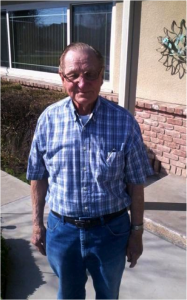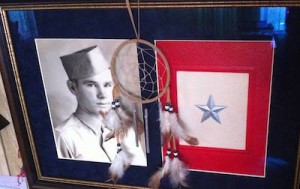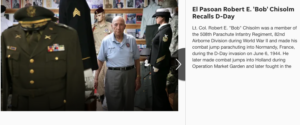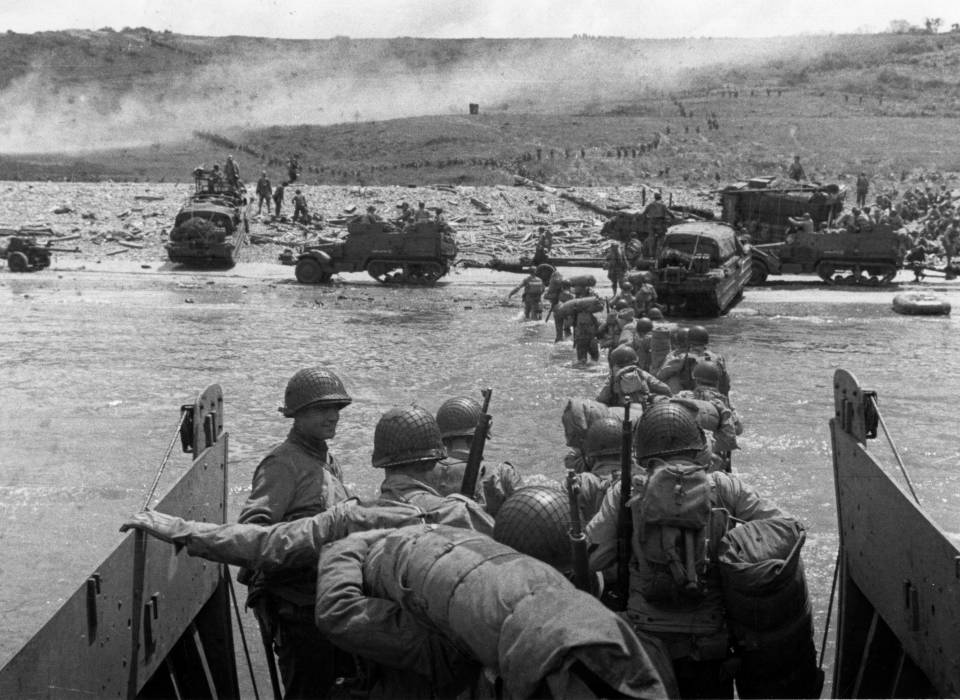Use controls above or click here to open this Hometown Heroes podcast in a new window
Episode #631 of Hometown Heroes, airing June 4-8, 2020, marks the 76th anniversary of the Normandy Invasion through the memories of three men who were fiercely involved in the D-Day combat, and also features President Franklin D. Roosevelt’s radio address to the nation on June 6, 1944.
“They fight not for the lust of conquest,” FDR explained in his prayer for the troops landing in occupied France. “They fight to end conquest. They fight to liberate.”
The entire text of Roosevelt’s prayer will soon be displayed at the National World War II Memorial in Washington, D.C. Follow this link if you would like to make a donation towards that effort. Watch the video below for the Friends of the National WWII Memorial’s D-Day Comemmoration:
After the D-Day prayer from the president, this episode transitions to the memories of David McCoy, who landed on Omaha Beach on D-Day with the 1st Infantry Division’s 18th Infantry Regiment.

“The idea we had in combat was that we weren’t gonna make it home,” you’ll hear McCoy recall as he paints a picture of the scenethat greeted him 76 years ago. “If you understand what 4th of July is, it was 4th of July and then some.”
After two unsuccessful attempts to unload vehicles, the LST McCoy was on finally landed forces just before noon on June 6, 1944. German artillery made it clear he was entering an extremely dangerous situation, but before he exited the ship, he watched through binoculars as some of his fellow Americans became D-Day casualties.
“I saw these troops going down the ramp and they were falling off in the water, about halfway down,” McCoy details. “I spotted a machine gun up on the hill that was shooting the troops.”
McCoy alerted his commanding officer to what he’d seen, and soon the message was relayed to a nearby destroyer escort, which fired a a shell in front of the enemy machine gun and one behind it. The third shell scored a direct hit, eliminating that specific threat to the invasion force. It did not stop McCoy from encountering heavy fire when he drove his half-track onto the beach. He spent that night in what he describes as a “grave” that he dug, subsequently driving the half-track over that hole in the sand for protection.
“The biggest problem was seeing so many bodies,” you’ll hear McCoy lament. “Most of my buddies were gone.”
Click here to access David McCoy’s complete original Hometown Heroes interview from 2013.

Another young American who landed on Omaha Beach on D-Day was E.T. Roberts, who came ashore with the 29th Infantry Division’s 116th Regiment. You’ll learn why he almost died before he ever made it onto the beach, and hear why he had to resort to grabbing the rifle of one of the fallen in order to defend himself once he landed.
“All I ever saw of my whole company was seven of us left,” you’ll hear Roberts recall. “I don’t know what ever happened to the rest.”
The sights, the sounds, and the smells his senses experienced that day have never faded from his memory, nor has a level of fear he describes as “past scared.”
“The water was solid blood,” he remembers. “The beach, you couldn’t walk without stepping on a dead soldier.”
Roberts endured D-Day without any injuries, but was wounded a month later near St. Lo, when he somehow survived being shot with five rounds from a German “burp gun” at point blank range. Access the complete original interview with Mr. Roberts through this link.

The final veteran we hear from is Bob Chisolm, who was just 18 years old when he parachuted behind enemy lines on June 6th, 1944 with the 82nd Airborne Division’s 508th Parachute Infantry Regiment. Chisolm is one of just over 300 American servicemen to claim “Triple CIB” status, having earned the Combat Infantry Badge in World War II, the Korean War, and the Vietnam War. D-Day was his very first combat experience, and he had to improvise after landing all alone, nowhere near the intended landing zone. The first thing he encountered after having to cut himself out of his parachute was a German motorcycle with a sidecar, which he was able to neutralize. Next, he came upon a glider. Everyone inside the glider had been killed. The 18-year-old made it into Sainte-Mere-Eglise, where he saw his fellow paratrooper John Steele dangling in his parachute from a church steeple, as famously depicted in the film, The Longest Day. After seeing an entire mortar squad wiped out by a German artillery shell, a new level of fear was unavoidable.
“The only thing that kept me going,” you’ll hear Chisolm say. “I would rather have anything happen to me, than to let my buddies down.”
Chisolm would be wounded on his 19th birthday on June, 23, 1944. He was wounded again during Operation Market Garden three months later, and wounded once more three months after that during the Battle of the Bulge. Link to the complete original interview with Bob Chisolm here, and if you’re ever in El Paso, TX, make sure to visit Lt. Col. Robert “Bob” Chisolm Park on the corner of Alabama and Harrison Blvd.

Leave a Reply